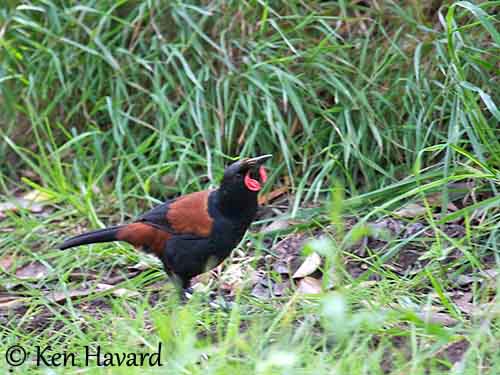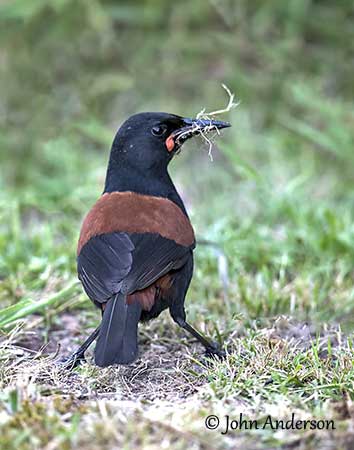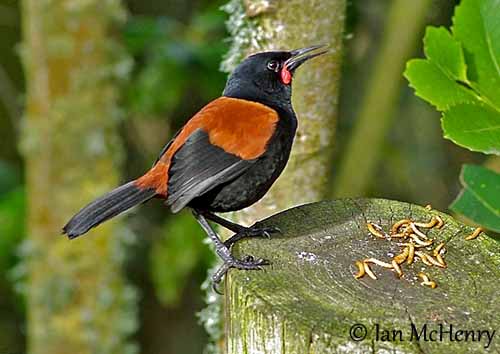
Fr: Créadion de Lesson
Ang: North Island Saddleback, Northern Saddleback, Saddleback (North Island)
Maori: Tieke
All: Nordinsel-Sattelvogel
Esp: Tieke de Isla Norte
Ita: Calleide caruncolato del Nord
Nd: Noordelijke Zadelrug
Photographers:
John Anderson
John Anderson Photo Galleries
Ken Havard
My Bird Gallery & Flickr gallery 1 & Flickr gallery 2
Ian McHenry
My New Zealand Birds
Text by Nicole Bouglouan
Sources:
HANDBOOK OF THE BIRDS OF THE WORLD Vol 14 by Josep del Hoyo-Andrew Elliot-David Christie - Lynx Edicions – ISBN: 9788496553507
KNOW YOUR NEW ZEALAND BIRDS by Lynnette Moon - New Holland Publishers – ISBN: 1869660897
BirdLife International (BirdLife International)
New Zealand bird status between 2008 and 2012
New Zealand birds and birding (Narena Olliver)
Wikipedia, the free encyclopaedia
Te Ara – The Encyclopedia of New Zealand
Tiritiri Matangi Open Sanctuary
Page family Callaeidae
Page Passeriformes Order
North Island Saddleback
Philesturnus rufusater
Passeriformes Order – Callaeidae Family
INTRODUCTION:
The North Island Saddleback, P. rufusater, and the South Island Saddleback, P. carunculatus, have very similar appearance, but they have different ranges, one in North and the other in South of New Zealand, and also different behaviour, breeding biology and vocalizations.
In addition, there is a significant morphological feature: the juvenile plumage is absent in North Island Saddleback, being almost similar to that of adults but duller, whereas in the other species, the juvenile has first brownish plumage overall with paler underparts and a chestnut wash on undertail-coverts.
For these reasons, the two species are today two full species since 2002. The family Callaeidae is confined to New Zealand and adjacent islands.
DESCRIPTION OF THE BIRD:
Biometrics:
Length: 25 cm
Weight: 60-95 g
The adult has glossy black plumage with contrasting rufous-chestnut to reddish-brown “saddle” from mantle to rump, extending to the secondary upperwing-coverts. There is a narrow gold band at the upper edge of the saddle, becoming brighter on older males. The tail is black with bluish sheen. The tip is rounded and the tail shows downward curve.

On the black head, we can see two red-orange facial wattles extending from the gape, over the malar area and down to the throat. They increase is size and become brighter during the breeding season.
The strong bill is black and slightly downcurved. The eyes are dark brown, surrounded by black eyering. Legs and feet are black.
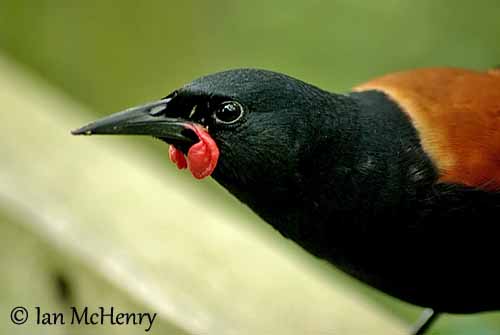
The female has similar plumage, but she is slightly smaller than male and has usually smaller wattles.
The juvenile resembles adults but with brownish-black plumage and duller mantle without yellow edge, weak brown barring on belly, and small, pink wattles. The undertail-coverts are chestnut.
RANGE:
The North Island Saddleback is found on North Island, New Zealand, but this species is restricted to islands off North coasts on Hen Island, where there is a natural population of about 500 individuals. There is other population on Kapiti Island, off South coasts of North Island. But some populations have been translocated too on several adjacent islands, within protected, fenced mainland sites on North Island.
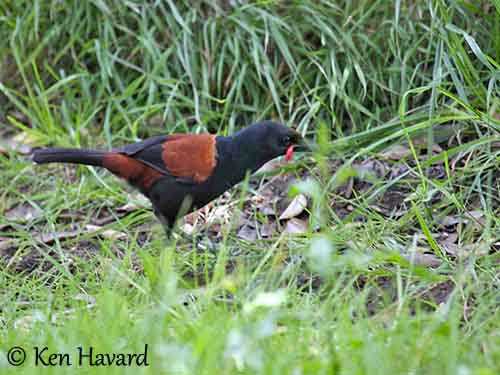
HABITAT:
The North Island Saddleback usually frequents forest on the islands, both inland and coastal, evergreen coastal forest and mixed lowland broadleaf forest, and second growth. This species may occur up to 700 metres of elevation.
However, the translocated population on Tiritiri Matangi has adapted to introduced plant species such as Pasarianthes of genus Fabaceae.
CALLS AND SONGS: SOUNDS BY XENO-CANTO
The North Island Saddleback is a noisy bird. A loud, repetitive chattering can be heard throughout the day “cheet-te-te-te-te” uttered by male and female. These calls are far-carrying through the forest. They also give quiet, soft and flute-like calls which are sexually dimorphic.
The territorial song by the male is a rhythmical phrase starting with 2-4 chips as introduction, followed by series of stereotyped and repeated phrases.
The song’s structure is dialectal, and about 200 different male’s songs have been recorded.
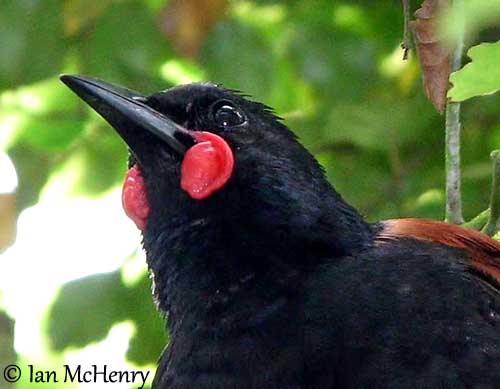
BEHAVIOUR IN THE WILD:
The North Island Saddleback is an active, noisy and vigorous forager, while searching for preys from the forest floor to the canopy.
It forages for insects by scratching through the leaf litter, and as gradually moving to the canopy, it uses its strong chisel-shaped bill to remove the loose bark and digs the rotting wood to locate invertebrates.
It searches out hidden insects and larvae by battering at the bark, and it investigates under epiphytes, on branches, trunks and leaves.
Its favourite food is the weta (orthoptera) and the bird usually acts as a Psittacidae, holding the large insect in one foot while pulling it apart with the bill. It also takes spiders, fruits and nectar from flax flowers (Linum).
As they forage for insects on the ground, they are often accompanied by New Zealand Fantails enjoying the disturbed insects.
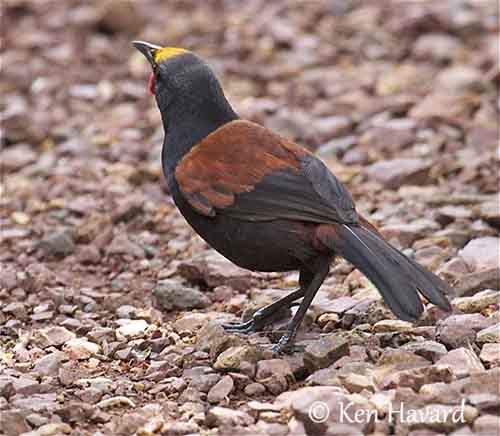
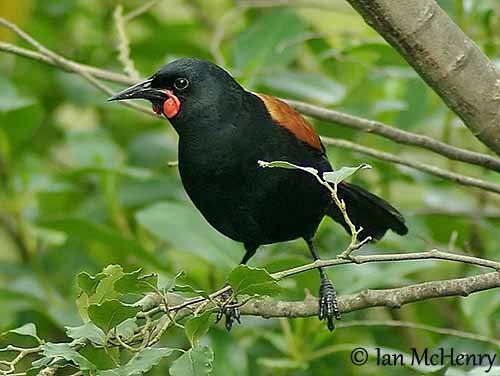
The North Island Saddleback is usually seen singly or in pairs, and in small family groups after the breeding season.
They are monogamous and form long-term pair-bonds, often for the life. They are very territorial and both mates maintain their territory by calling and singing. Territorial disputes may occur, involving threat displays, chases and occasionally physical fighting.
They roost in tree holes or in cavities on the ground, or beneath hanging vegetation, or in dense vegetation on the ground.
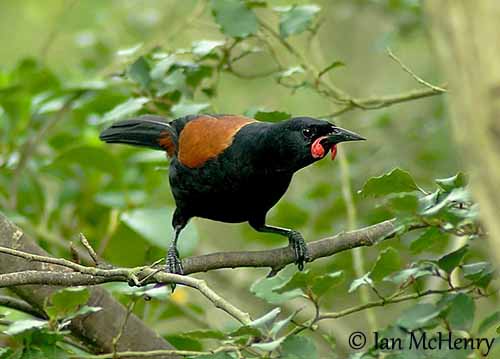
During the breeding season, the North Island Saddleback male performs courtship displays such as the typical “Archangel Displays”. It perches in tree or on the ground, and raises its wings while moving about rapidly in front of its mate. It may bring some vegetation in the bill, repeatedly dropping it.
While displaying, it often leads the female into a nest-cavity. Displays are accompanied by songs. Courtship feeding is performed all year round.
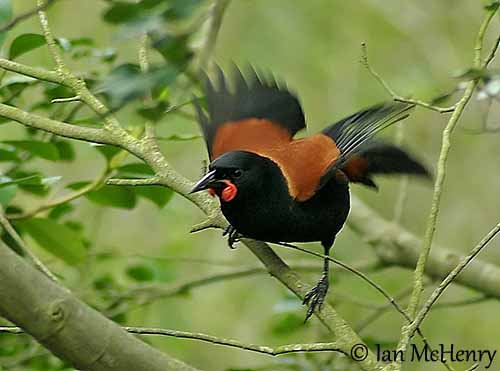
The adults are sedentary but the juveniles disperse within 3 kilometres. The translocated birds generally travel 3-5 kilometres before establishing their territories.
This species is a weak flier and cannot sustain height. It has short wings, rounded at tip. The bird performs more gliding than flapping flight.
REPRODUCTION OF THIS SPECIES:
The breeding season occurs in spring and summer, with the laying between August and March, and with the latest nestlings and fledglings in May. This species may produce 3-4 broods in good seasons.
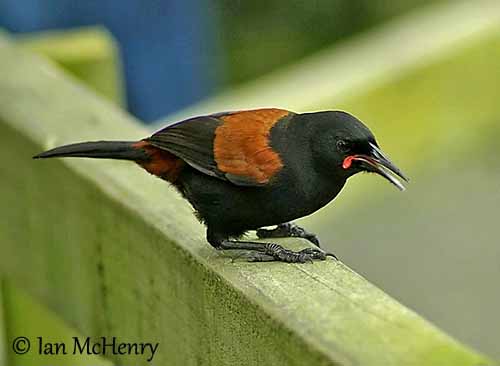
She lays 1-4 (usually 2) whitish eggs with brown speckles. She incubates during 18-20 days. She broods the chicks which are fed by both parents. They fledge 23-27 days after hatching.
The clutches are vulnerable to predation by rats, Morepork, raptors and Common Myna.
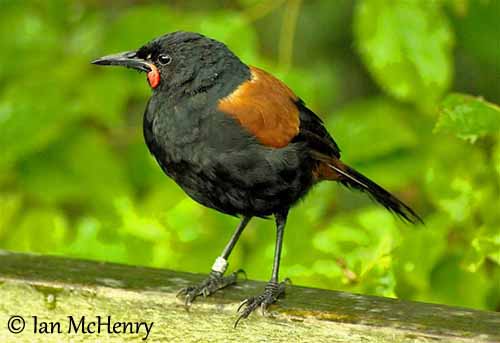
PROTECTION / THREATS / STATUS:
The North Island Saddleback is extremely vulnerable to predation by introduced mammals, and translocation of populations has been a good measure for protection and conservation of this species.
It has been successfully introduced on islands off North Island since 1964, and the global population is estimated now at about 6,000/7,000 individuals, and suggested to be increasing.
But the North Island Saddleback has restricted range and small populations in each site. The species is currently considered Near Threatened.
